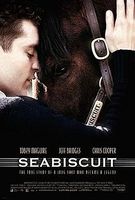
‘Seabiscuit’[1] is a 2003 film adapted from Laura Hillenbrand’s 2001 novel Seabiscuit: An American Legend[2].The film follows the life story of an undersized racehorse named Seabiscuit, during the time of the Great Depression in the United States. Seabiscuit is born with the promise of a great future owing to his bloodlines and the stream of success displayed by his ancestors before him. He however fails to make both the height and the grade, and is retrained to purposefully lose in order to boost the confidence of better horses. Seabiscuit is lucky enough to catch the eye of the equally down and out trainer Tom Smith, who sees something in the lazy horse which others did not. Tom stumbles upon the human version of Seabiscuit in the figure of Red Pollard, an ill sized jockey with problems of his own, and their pairing seems inevitable. Seabiscuit is given a second chance at being a racehorse, and Red is given a second chance at life itself.
Seabiscuit engages with the popular genre of family film, as it embodies several of the genre’s main components. Although Seabiscuit does not portray the stereotypical family, it does create an unconventional family of its own which functions in the same way as the conservative family. The characters of Red, Tom, Howard and Marcela are drawn together through the central figure of Seabiscuit and it is in this way that they bond as a family. The characters engage in typical scenes of family life, for example they dine together, and take pleasure in each other’s company and the sense of unity that this creates. The film also adheres to the family film genre in that it is aware of and inclusive of both child and adult audiences. The film has mildly problematic elements which ensure a sense of realism for the adult audience, but are also educational and reassuring for the child audience. Each central character possesses a flaw (Red’s temper and childhood abandonment, Charles’s loss of his son, Seabiscuit’s ‘incorrigible’[3] nature), which is overcome creating a sense of resolution and a return to the state of equilibrium. The film also embodies comical moments which contribute to the light hearted nature of the family film genre.
The official trailer for Seabiscuit immediately creates the sense of family which I touched upon in the previous section, as can be viewed here;
The film depicts Seabiscuit as central to the family which is created; he is the one who unites the characters and the reason they come together, he is essentially the healer, and the trailer engages with this notion in the way it introduces us to the central characters. They are displayed to us in a sequential and solitary manner; the words ‘a young man whose spirit was broken’[5] appear on screen and images of Red fighting follow, then the words ‘a millionaire who lost everything’[6] and a shot of Howard cradling his deceased son, and finally a shot which displays the words ‘a cowboy whose world was vanishing’[7] is reinforced by a clip of Tom saving a horse which is about to be shot. At this point we consider the characters as exclusive to one another; they are three separate and unrelated figures. The trailer then initiates a sense of unity by bringing the characters together through their shared misfortune as displayed in the line ‘three lost men found each other’ and reinforcing it with an image of Howard and Red greeting each other. However, it is the shots that follow which allow us to understand how the characters come together as the following sequence displays the phrase ‘who found hope, in an unlikely place’,[8] with images of Seabiscuit, confirming that he is the fuse who unites the family.
This sense of family grows throughout the film as the individuals are drawn closer together and the film entails many shots which display the characters engaging in typical family like activity. For example there are several scenes of Tom, Red, Marcela and Howard dining together and also visiting church and the cinema together.
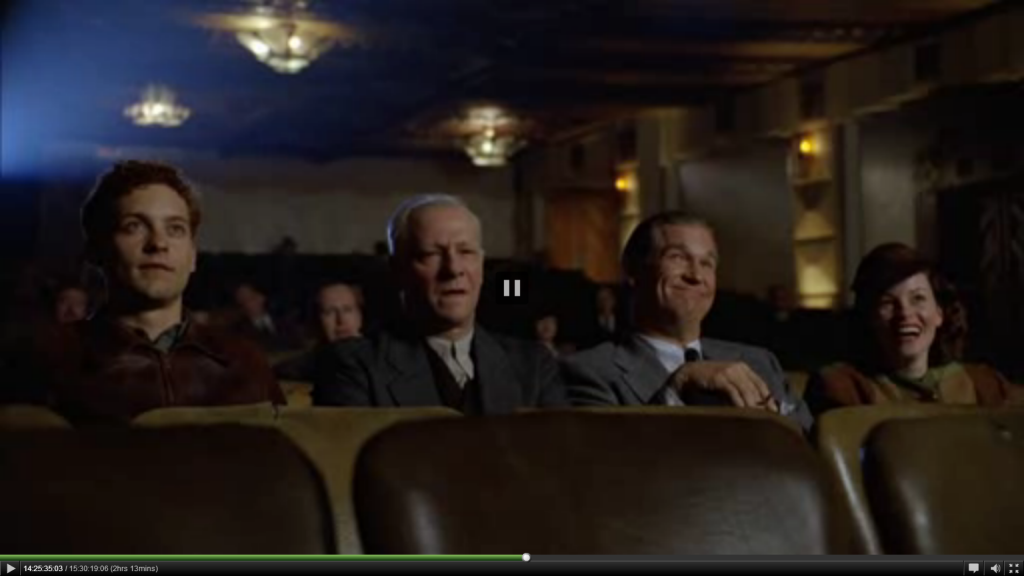
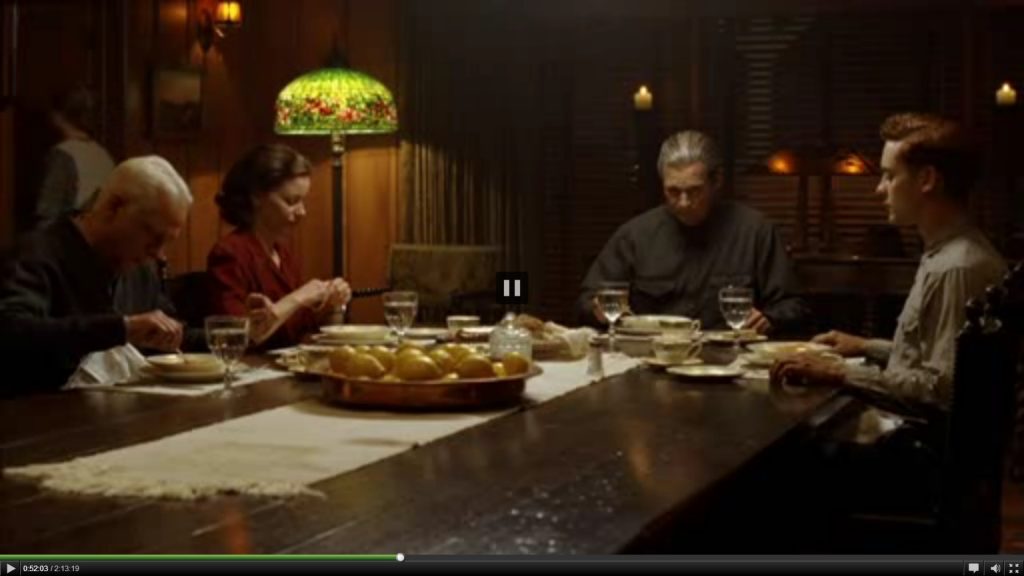
Although the cinema and church scenes are inevitably significant and contribute to the sense of family that the film intends to create, it is the dining scenes which I find to be most significant in creating a sense of family, as they inhabit a typically domestic space. It is essential to the film that it adheres to some of the typical notions of the family film genre in order for it to function effectively.
When we consider the fact that the central characters are introduced to us as ‘broken’, it is only fitting that we interpret Seabiscuit as a healing figure. The notion which the film evokes is that of certain closeness, whether it is the human bond we find in the relationship between Tom, Howard, Marcela and Red, or the human-animal bond between Red and Seabiscuit, can have healing properties. The film builds on this notion of healing from the very offset, as in the trailer, we follow the individual struggles and lives of the characters that are then united by Seabiscuit, and the connection which they make proves to be a powerful one. For example Howard is a man devastated by the death of his son and the subsequent divorce that evolved from the loss, however Seabiscuit brings him a new purpose, and with that purpose he finds both friendship and romantic love.
The relationship between Red and Seabiscuit is definitively the most powerful within the film and the specific use of close up shots of the pair reinforces the connection they have. The scene which shows Red and Biscuit stood together, both injured with bandaged legs emphasises the connection between the pair as their injuries are mirrored in the other; they are, like Tom, Howard and Red, united in their injury. The camera then pans upwards to a closer shot of the pair’s heads within close proximity of each other, highlighting their literal togetherness which mirrors the invisible bond between the two. The affinity between the pair is further reinforced by the colours of the shot, Seabiscuit’s white bandage is paralleled in Red’s white bandage, and the warm orange tones of Red’s hair have a likeness to the mahogany tones of Seabiscuit’s coat.
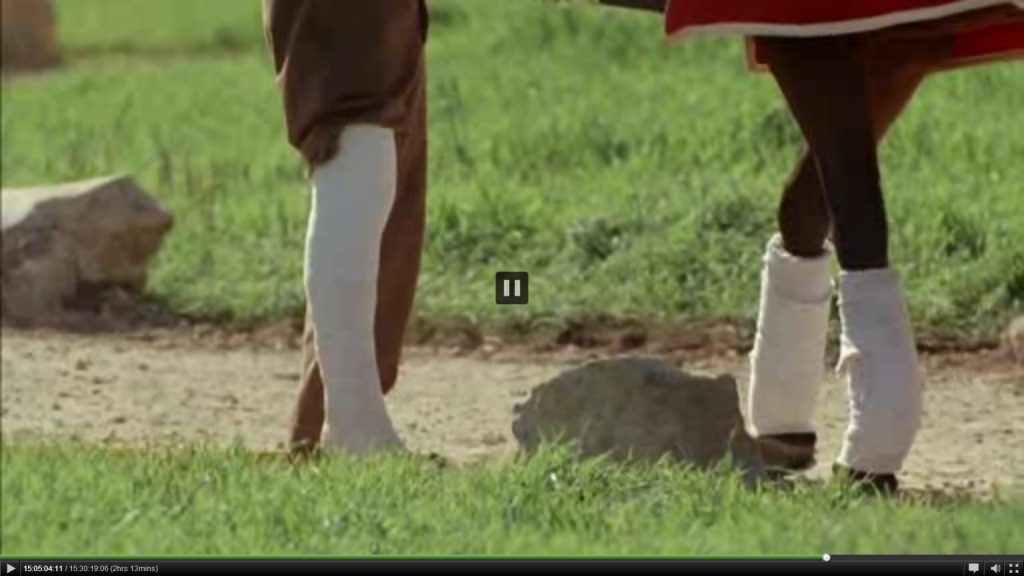
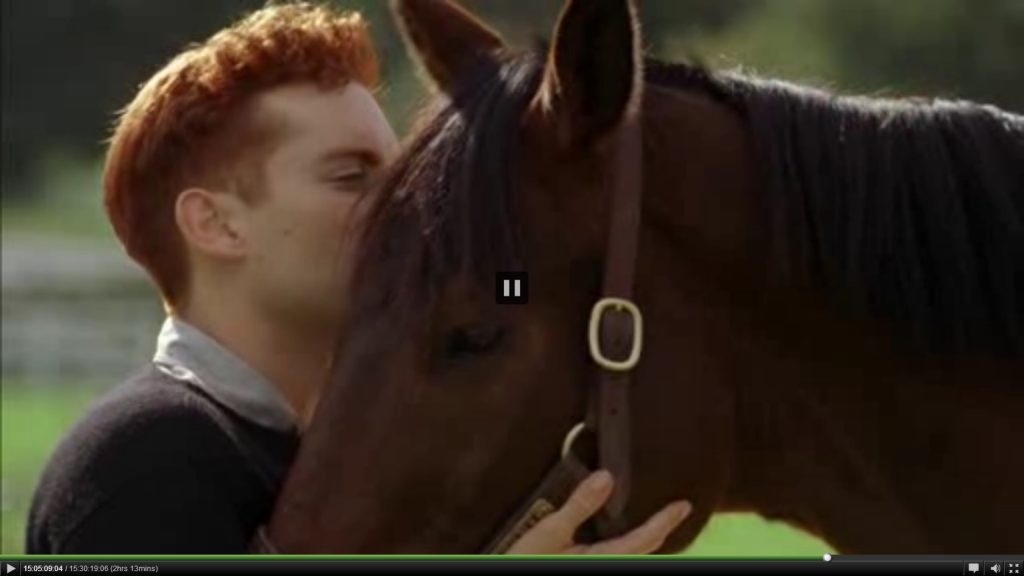
The use of colour within the second shot is again something to consider here, as the warm brown, orange and peachy tones of Red and Seabiscuit contrast the vibrant green in the background – this illuminates our subjects in the foreground of the shot, making them appear distant from anything else within the frame, subsequently placing them closer together. This sense of togetherness reinforces the notion of family that has been constructed throughout the film, once again ensuring that the film engages with its genre and target audience.
Undoubtedly Seabiscuit is a tale of healing, and the representation of Seabiscuit within the film depicts him as a healer. Although all of the film’s central characters were flawed through loss and abandonment, including Seabiscuit himself with his incorrigibility, he brings hope. He, much like his human companions, is down and out, but when given a chance he proves himself to be capable of great things, and this inspires the other characters of the film. Seabiscuit creates a sense of hope and the potential for a better life, not just for those in immediate contact with him, but implicitly for the whole of America during the time of the Great Depression, and similarly the contemporary audience of the film following the September 9/11 attacks of 2001. The closing line of the film reinforces this notion that Seabiscuit was a symbol of hope as the narrative voice of Red states that ‘everybody thinks we found this broken down horse and fixed him, but we didn’t, he fixed us, every one of us, and I guess in a way, we kinda fixed each other too’. [9] In addition to being a symbol of hope, Seabiscuit was also a symbol of unity. He brought together four previously isolated and emotionally wounded individuals and gave them each other. A family emerged centred around the colt, and characters that fundamentally existed as jockey, owner and trainer became connected in a much more sentimental and intricate manner; he united the individuals around him and the nation as a whole.
Seabiscuit resonates with other animal films in the sense that we can learn something from the animal, some kind of moral lesson. In Seabiscuit we learn the importance of second chances and the power of hope, belief and the human-animal bond. This idea of being able to learn something from animals is also present in Jean-Jacques Annaud’s 1988film ‘The Bear’,[10] as at the end of the film the hunters are reformed. The tables are turned on them and they become the hunted, yet the bear does not kill them, it appears merciful. It is at this stage that the hunter seems to come to understand the emotion of mercy and the emotional complexity of the bears – they are not simply mindless, vicious creatures as he originally thought. Through this new understanding of bear’s complex nature, he reconsiders his stance as a hunter – an example of how he has learned through animal interaction.
[1] ‘Seabiscuit, dir. by Gary Ross (Dreamworks Pictures, 2003).
[2] Laura Hillenbrand, Seabiscuit: An American Legend ([n.p.]: , 2001).
[3] Seabiscuit. Dir. Gary Ross.
[4] , () <https://www.youtube.com/watch?v=x3BcfoKhvzc> [accessed 3 December 2015].
[5] Seabiscuit. Dir. Gary Ross.
[6] Seabiscuit. Dir. Gary Ross.
[7] Seabiscuit. Dir. Gary Ross.
[8]Seabiscuit. Dir. Gary Ross.
[9] Seabiscuit. Dir. Gary Ross. 2003.
[10] The Bear. Dir. Jean-Jacques Annaud. 1998.